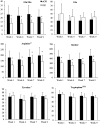Effects of military training on plasma amino acid concentrations and their associations with overreaching
- PMID: 32363923
- PMCID: PMC7357143
- DOI: 10.1177/1535370220923130
Effects of military training on plasma amino acid concentrations and their associations with overreaching
Abstract
The diagnosis of overtraining syndrome and overreaching poses a great challenge. Military training aims at improving the physical performance of the conscripts, but an excessive training load could also lead to overreaching. This study of Finnish conscripts provides new insights into the pathophysiology of overreaching and overtraining through amino acids concentrations. In addition to confirming the possible use of plasma glutamine/glutamate concentration to indicate and predict overreaching, we made a novel finding, i.e. low alanine and arginine concentrations might have a role in performance decrement and fatigue related to overreaching. Moreover, this study is the first to show the possible association between amino acids with putative neuronal properties and overreaching. Thus, the present findings might help to detect and prevent overreaching and offer a reliable diagnostic approach. In order to avoid overreaching, military training should be planned more periodically and individually, especially during the first four weeks of military service.
Keywords: Overreaching; amino acids; glutamine–glutamate ratio; metabolism; military training; overtraining.
Figures

References
-
- Meeusen R, Duclos M, Foster C, Fry A, Gleeson M, Nieman D, Raglin J, Rietjens G, Steinacker J, Urhausen A; European College of Sport Science; American College of Sports Medicine. Prevention, diagnosis, and treatment of the overtraining syndrome: joint consensus statement of the European College of Sport Science and the American College of Sports Medicine. Med Sci Sports Exerc 2013; 45:186–205. - PubMed
-
- Coutts A, Reaburn P, Piva TJ, Murphy A. Changes in selected biochemical, muscular strength, power, and endurance measures during deliberate overreaching and tapering in rugby league players. Int J Sports Med 2007; 28:116–24 - PubMed
-
- Coutts AJ, Reaburn P, Piva TJ, Rowsell GJ. Monitoring for overreaching in rugby league players. Eur J Appl Physiol 2007; 99:313–24 - PubMed
-
- Halson SL, Lancaster GI, Jeukendrup AE, Gleeson M. Immunological responses to overreaching in cyclists. Med Sci Sports Exerc 2003; 35:854–61 - PubMed
-
- Smith DJ, Norris SR. Changes in glutamine and glutamate concentrations for tracking training tolerance. Med Sci Sports Exerc 2000; 32:684–9 - PubMed
Publication types
MeSH terms
Substances
LinkOut - more resources
Full Text Sources
Medical

